News for Summer 2008
The 2008 AGM at Norwell
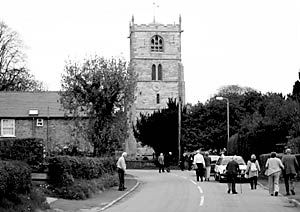 |
Once again we were lucky with the weather, when over eighty members of the Society got together for the Society’s AGM, with the sun shining upon us. Norwell was our location this year, and we met in the new, attractive village hall. It is surprising how many of us had not visited this not-so-remote corner of our county, just a short drive from Southwell and about a mile from the A1. Norwell is a quiet, peaceful and attractive village with a fine church.
The AGM was relatively swift and painless. All the officers were re-elected, and Dr Richard Gaunt was elected as the new History editor of Transactions; he will work with Adrian Henstock for the next year. Adrian will remain as Record Series Editor, and members were informed of the progress of the Senior Map project, which sounds extremely exciting. Steph Mastoris returned to Nottinghamshire from Wales to provide more details – we were very pleased to see him again.
Ken Brand, Penny Messenger and Peter Reddish were re-elected to the Council, and David Crook was elected for the first time, having been co-opted last year. The President, Dr Rosalys Coope welcomed members, the Chairman conducted the business, and John Wilson gave his first report as the Society’s Treasurer. John Hamilton introduced members to the new membership leaflet, which will be part of a recruitment campaign this year.
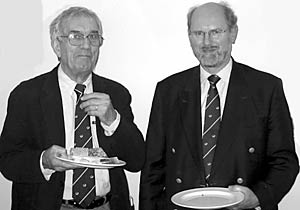 |
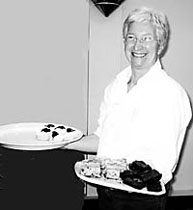 |
Ken Brand and David Hoskins |
Dr Elizabeth Jones |
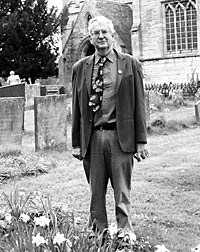 |
Michael Jones. |
After the business of the AGM, Michael and Elizabeth Jones gave a joint presentation on the history of Norwell, emphasizing the importance of the village’s links to Southwell, which was one reason there were no real gentry influences locally. We then walked to the Church of St Lawrence, where Michael [pictured left] gave a full description of its interesting features, including fine effigies, a green man in the transept ceiling, and a rood stair. If you have never been to this delightful church, it is well worth a visit. Members were given a copy of the Norwell Heritage Trail, prepared by the local heritage group, and funded by the HLF, so that on the way from the church to the village hall it was possible to study some of the buildings, including the three vicarages and the mill. We would especially like to thank Elizabeth and Michael Jones for hosting the event and for giving so much information about their lovely village. Thanks must, of course, go to the Ladies of Norwell for the splendid tea, and for making us so welcome. And thanks also to all those who helped to make this an enjoyable AGM in so many ways. Barbara Cast and John Beckett
THOROTON SOCIETY LUNCHEON 2008
Southwell Minster is 900 years old this year, and so we are returning to Southwell for our Annual Luncheon. This year it will be held at the Saracen’s Head, which was the venue a few years ago and where we received a very good lunch. The date is 1 November, and you will receive details and a booking form in the summer mailing.
Thoroton Response Group
A sub-group of the Thoroton Society Standing Committee, titled the Thoroton Response Group, has been established. This is a new initiative for the Society, aimed at strengthening our activities in supporting the preservation of our county’s historic settlements, buildings, monuments and landscapes. The group consists of Howard Fisher, who is the County and CBA planning representative; Ken Brand, who keeps a wether eye on City planning matters; Pete Smith, one of our Council members with considerable heritage experience; and Barbara Cast. It is our intention to co-ordinate responses relating to or affecting Nottinghamshire on:-
- Planning applications on listed buildings, those in conservation areas or any other considered of historic or archaeological interest.
- Draft conservation area plans or appraisals of or amendments to existing conservation areas.
- Government, local government or other policy documents relating to the built, historic or archaeological environment, or any policies or plans which might affect these or to any part of such areas in Nottinghamshire.
We will also ensure that we provide feedback via the Newsletter on activities to keep members informed and, where considered necessary, seek publicity on issues of planning concern and sites or buildings in danger.
We hope members will support the group by letting us know of their local concerns about planning applications, changes in land management, threats to local landmarks etc. We will then try to investigate and comment to the appropriate authority if we feel that would assist. In the first instance please contact Barbara Cast, Honorary Secretary, if possible by email at bandpcast@btinternet.com, or at the usual address.
Delving into the Society’s Archives
In December 1949 the following was written as an introduction to the first edition of the Journal of the Nottingham Archaeological Society:- ‘There are many who cannot take an active part in field archaeology, and cannot attend all the meetings of the Society, and yet are keenly interested in the work. Hence this small quarterly volume, which it is hoped will fill to some extent, a long felt want.’
The articles in this ‘new venture’ included one on Admiral Howe of Langar who, after renowned service in the Royal Navy, became First Lord of the Admiralty in 1783 and who was made Baron Howe of Langar on 17 August 1788. He lies in Langar Church, the ‘Cathedral of the Vale’ where also, we are told, is found ‘a magnificent cloth of rich Italian embroidery in gold thread on a purple ground, embossed with pictures in many colours, discovered in one of the men o’ war captured on the Glorious First of June’, a sea battle which, the Journal tells us, was ‘the Admiral’s crowning achievement’.
More snippets from the Society’s veteran journals in further issues, but one other comment – amongst the contributors is one B W Beilby, with an article on medieval sanitation. Barbara Cast
The Nottingham Review 1808-1870
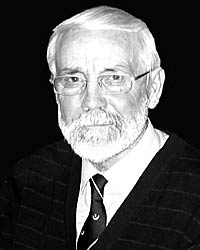 |
Terry Fry (pictured right) writes: It is 200 years since the Nottingham Review was first published. Founded in 1808 by Charles Sutton, it was the first truly radical newspaper. He favoured free trade in corn and also attacked the Government’s participation in the Napoleonic Wars. He was sentenced to a year in gaol for libel, but continued to publish the paper from prison.
The Review was published each Saturday, initially from Bridlesmith Gate. By the late 1830s it had a circulation of c.3,000 and always sold more copies than the Nottingham Journal. The Review editors were not particularly interested in local affairs; it was not sold as a purely Nottingham newspaper, and had a readership extending into the county and to Leicestershire and Derbyshire.
The paper passed to Sutton’s son Richard in 1828, who strongly promoted the Reform Bill and insisted that further reforms should include universal suffrage, annual parliaments and voting by ballot. Naturally he supported the Chartists, and invited Feargus O’Connor to stand as MP for Nottingham. O’Connor described the Review as ‘the best supporter of our cause of all the provincial newspapers’. Nottingham, said the Review, was tired of ‘do-nothing, kid-glove reformers’. Sutton also supported Robert Peel in the campaign to abolish the Corn Laws, finally achieved in 1846.
Richard’s son John joined the Review and was especially concerned with promoting enclosure. His editorials were influential in achieving the Enclosure Act of 1845, which was also welcomed by the Tory newspaper, the Nottingham Journal. The Whigs were usually in power in Nottingham during the Review’s life, making it relatively easy for the Suttons to support radical measures.
When on 30 December 1870 the Nottingham Review was published for the last time, the only reference to its passing was a notice on page 4 informing subscribers that it would ‘cease as a separate newspaper, and in future be incorporated with the Nottingham & Midland Counties Daily Express’. So ended a short but influential life, although ‘its radicalism had for long been of the most moderate and constitutional character’. Its presentation was said to be the most ‘pleasing and enterprising’ of the local newspapers. AC Wood in Transactions of the Thoroton Society, 1955, Vol 59, added: ‘Here is an invaluable source of material for the study of civic life and development in the 19th century, still hardly touched by the local historian’. Terry Fry
The Dovecote at Thoroton
It was described some year’s ago as ‘sprucely thatched’. However, the medieval stone dovecote in the village of Thoroton, the home village of Dr Robert Thoroton, is now sadly not so sprucely thatched. Thoroton’s dovecote belongs to the Nottinghamshire Building Preservation Trust which is trying to raise funds for much needed repairs, including the thatch. This Society is unable to contribute as it is a charity but members who are interested in the dovecote and its associations with our eponymous inspiration may wish to do so. If so, Marian Edwards, the NBPT secretary, would be pleased to hear from you. Contact her (tel 01636 819555), or send a cheque to NBPT, Minster Chambers, Southwell, NG25 0HD.
Research Agenda for the Historic Environment of the East Midlands
The project, funded by English Heritage as a component of its Historic Environment Enabling Programme, began at Leicester University with a book published in 2006, The Archaeology of the East Midlands, An Archaeological Resource Assessment and Research Agenda (ed by Nicholas J Cooper). Further information is available at: www.le.ac.uk/archaeology/research/projects/eastmidsfw/
Nottingham University then took on responsibility. On 7 May David Knight (Director of Trent & Peak Archaeology, now part of Nottingham University), and Carol Allen (Archaeological Consultant) coordinated a public seminar on the Research Agenda for the Historic Environment of the East Midlands on the main Nottingham University Campus. Some 130 people attended, described as representing the Historic Environment Community, from the six counties of Derbyshire, Leicestershire, Lincolnshire, Northamptonshire, Nottinghamshire and Rutland. Presentations were given by staff from the Universities of Birmingham, Kent, Leicester, Northampton and Nottingham.
The research questions were outlined for each archaeological period (see website at http://www.nottingham.ac.uk/tpa/research/project3/index.htm) from the Palaeolithic to modern followed by open discussion. How different some of the periods were from others, but also how there were connections, the flint for tool making in post-glacial times in Nottinghamshire, for instance, coming from the movement of the glaciers in the Palaeolithic.
The East Midlands is more a modern political area than an area delineated by archaeologists within which to follow particular research questions. It straddles the classic division of Britain by Sir Cyril Fox into the Highland and the Lowland Zones. It was interesting to hear the questions coming from some speakers applying to the whole of Britain, while other speakers presented questions restricted to the East Midlands. Following the seminar David Knight and Carol Allen will generate a five-year prioritised action plan to be launched in September 2009. We are already talking with them over when they might have time to lecture to us on what will emerge of special relevance for Nottinghamshire. Leslie Cram
OBITUARY – MICHAEL BROOK (1926-2008)
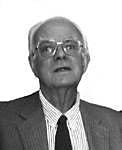 |
Michael Frederick Cecil Brook, formerly Special Collections Librarian at Nottingham University, died on 27 March 2008. Born in Bristol, he attended Abingdon School and Pembroke College Oxford, where he read Modern History, before taking up a career in university libraries. He worked at Bristol and Sheffield (where he developed an abiding love for the West Riding), and became an ALA in 1953, before moving to Southampton.
In 1962 Michael lived in the United States and spent ten years in Minnesota Historical Society’s library, where he developed skills as a bibliographer and reference expert, publishing his valuable Reference Guide to Minnesota History in 1974, with a supplement in 1983. He also found a special interest in the Swedish and other Scandinavian immigrant communities in Minnesota, and notably their labour history. He contributed to a number of scholarly works on these topics (he had learned Swedish in order to study the field) even after he left Minnesota.
Michael returned to England in 1972 to take up the new post of Special Collections Librarian at Nottingham University Library (now the Hallward Library). He had responsibility for developing and organizing the East Midlands Collection, in addition to the other printed special collections, and added considerably to its strength. He also formed links with his colleagues in the County Library’s equally strong Local Studies Library and the County Archives, as well as with the Thoroton Society, which deposited its own library in the University under his care. He produced a number of reports on recent publications for the Bulletin of Local History: East Midlands, and joined Sue Robinson for an Introductory Bibliography of the Hosiery and Lace Industries in Nottingham. He was responsible for the Nottinghamshire volume of the British Library’s Bibliography of British Newspapers (1987), the definitive listing of the county’s newspapers since 1710. His most important work appeared in 1988, after early retirement. He continued to compile what has become the standard reference work for local historians, A Nottinghamshire Bibliography: Publications on Nottinghamshire History Before 1998, published in 2002 by the Thoroton Society.
Michael was well known and well liked in the active local history world of his adopted city and county. He was also noted as an expert on ecclesiastical buildings and the 19th-century architecture of Nottingham, serving both the Victorian Society and the Chapels Society as a knowledgeable and enthusiastic guide (both on paper and in the flesh). By the time of his death he had been in poor health for some time, and had recently moved to an Abbeyfield home following a fall. His enthusiasm and gentle concern for the world about him will be greatly missed by his many friends and former colleagues, including those able to attend his funeral at the Russian Orthodox Church of the Holy Transfiguration in Carlton: typically, an unusual but moving ceremony. Peter Hoare, University Librarian, University of Nottingham 1978-1993.